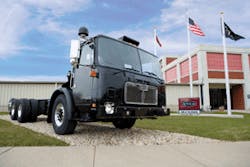Intended at least initially for Class 8 refuse truck applications, a new diesel hybrid system uncouples the engine from the drivetrain and replaces the transmission with a hydraulic pump and hydrostatic engines. Specialty truck manufacturer Autocar LLC and its partner in the project, Parker Hannifin Corp., unveiled a working prototype of the E3 heavy-duty hybrid truck at Waste Expo in Las Vegas that it said has recorded up to a 50% decrease in fuel consumption tests under stop-and-go conditions typical of a refuse collection route.
In addition to its significant fuel savings, the E3 significantly reduces brake wear and operating noise, according to Autocar. Plans call for building a small number of beta vehicles this year for field and fleet testing, which a limited commercial launch anticipated in late 2007 or early 2008, Autocar officials said.
The E3 is a hydraulic hybrid, collecting energy from vehicle braking and storing it as compressed hydraulic fluid in accumulators. At vehicle launch, the accumulated fluid drives hydrostatic motors, which in turn deliver power to the driveline. Once the vehicle reaches 24 mph, or when the accumulated pressure is depleted, the truck’s 8L Cummins ISL diesel drives the unit’s hydraulic pumps and hydrostatic motors.
At speeds above 40 mph, the vehicle’s hydraulic unit bypasses the pumps and becomes a direct-drive transmission with a top vehicle speed of approximately 65 mph.
Developed by Parker, the RunWise hydraulic technology provides all vehicle braking down to 3 mph, at which point the standard mechanical braking system takes over.
By replacing the typical automatic transmission used in its Class 8 refuse collection trucks and downsizing the engine from its standard 9L model, the hybrid weighs no more than the current Autocar chassis. Although no estimates were offered, the goal for the project is a two- to three-year. return on investment for the added cost of the hybrid system based on fuel and maintenance savings, according to company officials.
About the Author
Jim Mele
Jim Mele is a former longtime editor-in-chief of FleetOwner. He joined the magazine in 1986 and served as chief editor from 1999 to 2017.
